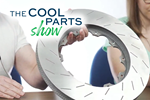Spanish machine tool builder Etxetar, along with its sister company, laser deposition specialist Talens, together are working with a major auto producer to develop a process using additive manufacturing to mass-produce superior-performing automotive brake discs. Coming environmental regulations in Europe will limit the amount of brake dust cars are permitted to release through the normal friction of stopping. The solution: precise laser metal deposition, the top layer of which will be either tungsten or titanium carbide for wear resistance. During a visit to Etxetar in Spain, I learned about this process.
Transcript
I am in Elgoibar, Spain, at the machine builder Etxetar, learning about the future role that additive manufacturing is going to play in automotive brake disc production. Etxetar is working with a major auto producer to develop thin laser metal deposition of what will likely be titanium carbide for a more effective surface for brake discs. The aim in Europe relates to coming environmental regulations. The harder surface means less brake dust will get into the atmosphere, but one effect of this is brake discs that will last a whole lot longer because of the harder surface. The way that this process will work, there is an initial layer of about 120 microns thick of stainless steel, which is an intermediate layer, and then the outer surface is a mix of stainless steel and the carbide, about 250 micron thick. These are very thin, precise layers, and that requires a lot of process control. And that’s what Etxetar is working on right now with this test machine, looking at issues like powder consistency, flowability and other issues related to powder, software control, closed loop control over the laser metal deposition process. And then from there, what will come next is the machine building: building production machines for full-scale ongoing production, likely beginning in 2027, when this technology will come to consumer automobiles.
Related Content
-
8 Cool Parts From Formnext 2024: The Cool Parts Show #78
End-use parts found at Formnext this year address various aspects of additive's advance, notably AM winning on cost against established processes.
-
IndyCar's 3D Printed Top Frame Increases Driver Safety
The IndyCar titanium top frame is a safety device standard to all the series' cars. The 3D printed titanium component holds the aeroscreen and protects drivers on the track.
-
This 3D Printed Part Makes IndyCar Racing Safer: The Cool Parts Show #67
The top frame is a newer addition to Indycar vehicles, but one that has dramatically improved the safety of the sport. We look at the original component and its next generation in this episode of The Cool Parts Show.












